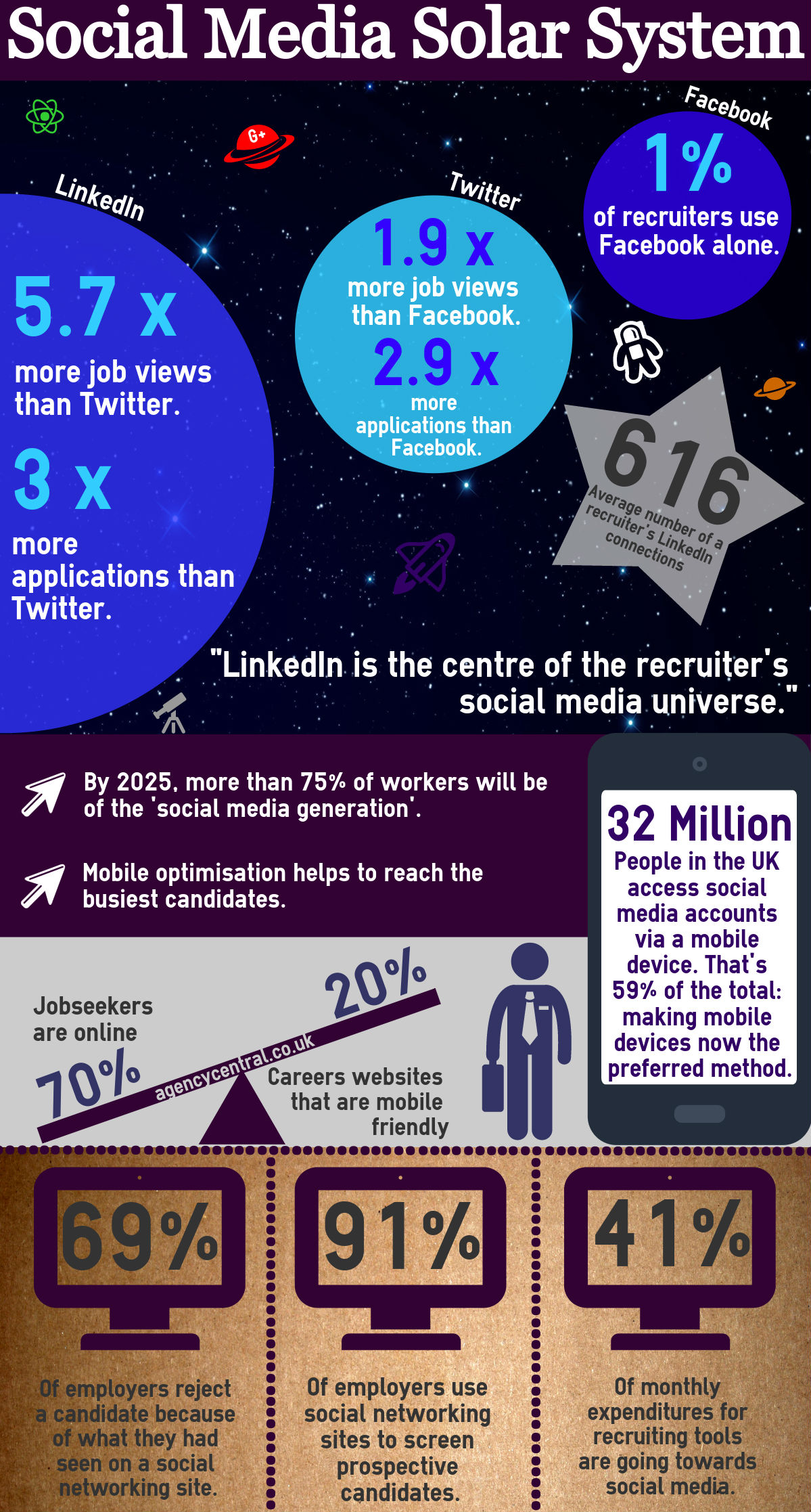Social media recruitment – something that is super-familiar to us all as recruitment and HR professionals, right? Not always. Even if you grew up in the digital age, it can be tough to get a handle on how these powerful tools can be used to our advantage. There’s far more to it than just searching LinkedIn or e-stalking candidates on Facebook too! Read on and find out why.
Why social media?
The first question you might be asking yourself is ‘why would I want to recruit through social media’? Well quite simply, it’s becoming more and more normal for people to spend time on social channels – putting all sorts of information about their lives, skills, and careers into the public domain. Why wouldn’t you want to take advantage of that? Social recruitment is far more than just a buzzword.
One of the selling points of recruiters is that they match candidates with employers based on their subtleties – and this would be much easier if people didn’t have to be met in person to find out what those subtleties are.
On top of that, put yourself in the shoes of someone who is a success in the role you are trying to recruit for. Are they actively seeking work in the job market? Perhaps. Or perhaps not. Perhaps they are currently quite happy in their (very successful) work, and consequently aren’t looking for anything else. Social channels can bypass this little detail and allow you to consider people before they’ve even thought about looking for a job. After that it’s really down to the quality of your offer.
Then, consider the recruitment channels you use at the moment – as well as the amount of spam applications they tend to generate. Wouldn’t it be nice to cut that down? Well, by taking a more proactive approach and searching for your ‘purple squirrel’ through social media, you can decimate that workload.
Finally, let’s have a think about CVs and cover letters. Do they really tell you that much about the person concerned? Well, yes you get a list of qualifications and a potted history of their career – but they don’t really give you a lot in the way of personality, do they? One of the selling points of recruiters is that they match candidates with employers based on their subtleties – and this would be much easier if people didn’t have to be met in person to find out what those subtleties are. By giving us a deeper insight into the way a candidate acts, social channels can do that.
If you’re still not convinced, maybe the statistics can do it for you:

Ok, but how?
So, hopefully we’ve now demonstrated that there’s something to this whole social media recruitment malarkey besides just being able to say ‘oh yes, I do that too’. But how do you actually do it? Well first, you’ve got to understand the different strengths and weaknesses of the main social media channels in order to be able to pick your weapon(s) of choice.
Follow Agency Central on Facebook.
It’s long been known that Facebook is one of the best places to vet candidates. Unfortunately, most candidates worth their salt have now realised this.
This is probably the first thing that anyone in the UK thinks of when you mention social media. More or less everyone uses it to some extent. Whilst this means that it’s great in terms of finding a particular person, its personal slant means that it’s not always the best place to do recruitment work.
As you can see from the infographic above, it’s long been known that Facebook is one of the best places to vet candidates. Unfortunately, most candidates worth their salt have now realised this, and will attempt to circumvent your sleuthing around their personal lives by using either a pseudonym, more aggressive privacy settings, self-censorship, or a combination of all these things.
Using Facebook for recruitment itself can be a bit of a mixed bag. The problem is that it’s a very public channel and is necessarily going to introduce a lot of chaff into your tasty bowl of wheaty goodness. For that reason, we’re not going to concentrate too much on it right now. That’s not to say that you shouldn’t use Facebook to recruit – because actually a lot of major companies do this very successfully – but if you’re after a focussed technique, then there are probably better sources to go to.
Follow Agency Central on Twitter.
Twitter sometimes gets a bit forgotten when it comes to recruitment. Whilst everyone knows that it’s a trendy place to get your feelings across, making use of that in our context can be easier said than done for many people. Here’s how.
How can we make your Twitter account become a tropical island of inspiration in a stormy sea of trivia?
The first thing you need to understand is that in order to be successful on Twitter, you’re first going to require a good presence on there. The amount of time that you will need to spend on this varies, but it will be reasonably considerable. Now you may or may not be at the point where you can afford to hire a dedicated social media manager or team, but for the purposes of this article we’re going to assume that you can’t.
So, either you’ve decided to take charge of your Twitter account yourself, or you’ve press ganged a member of staff into doing the honours. The first thing you need to do is to come up with a username. It doesn’t really matter what you choose as long as it’s relevant and easily searchable – but the shorter it can be, the better (it’ll make it easier for people to share, or ‘retweet’ your content). It should also reflect your company in a good light.
Next up, it’s time to get cracking on polishing up the rest of your account. This is important, because it’ll help to make you look like more of an established player on the Twitter landscape. Give yourself an icon and write a short bio. What you want to choose will vary slightly depending on the ‘voice’ you decide to give your account – which is discussed below.

So, how can we make your Twitter account become a tropical island of inspiration in a stormy sea of trivia? Well, now it’s got its looks sorted out, we need to give it something that’s sorely lacking in many nowadays: personality. We don’t want it to end up like another soulless cookie-cutter celebrity now do we?
The voice that you choose is up to you, but the choice remains the same whether you’re a dedicated recruiter or another type of business. If you’re a HR department within a larger firm, then you need to decide whether it’d be best for you to have your own ‘careers’ account, or whether you should link in with other departments to form a single account. In any case, there are three main types of voice that you could choose from:
The corporate voice
Everyone’s familiar with this one, aren’t they? The impersonal tones of a corporate entity, broadcast throughout the Tweetosphere on wings of electromagnetic impulse. You may notice that we weren’t overly positive there – and there’s a reason for that. Unless you’ve got a very strong brand – like say, Red Bull, or PlayStation (who both really work at it), you run the risk of looking like just another ‘me too’ Twitter account.
Now there’s nothing to stop you from investing some (considerable) time, energy, and imagination into this and absolutely ruling Twitter within the next month, but let’s be realistic here right? Building an online brand is not a particularly easy task – and if you attempt this with a weak or disliked brand, then you may turn-off potential clients.
There are some benefits to a corporate voice at least. Because of the fact that it’s impersonal, you can easily change the person responsible for maintaining the account without any of your followers having to know. Great if you’ve got a high turnover of staff? Yeah.
The boss’s voice
We’re guessing that this is you, right? Here’s your big chance to build your brand around yourself at last! Ok, that sounds more than a little bit egotistical, but let’s be honest here – you’re the one putting the hours in and guiding the company in the right direction aren’t you?
Unfortunately, those hours that you put in lead us to the big problem with this approach. It’s time-consuming. Like really time-consuming. And are you really going to trust someone else to manage your personal social media presence? Of course you aren’t. The personal tone that it provides therefore comes with some pretty big trade-offs.
The employee’s voice
See those people around the office? They’re your employees. Ok, we jest – but still, aren’t the people responsible for the day-to-day running of your business really its best spokespeople?
It will probably be that many of the people reading the tweets you put out will be employees themselves, too – so they may find it easiest to relate to people who are on a similar level in the corporate hierarchy.
The one main downside to using an employee’s voice is one that you may have guessed. Not only are you placing a great deal of responsibility on that individual’s personal image, but if they ever leave the company or have to be replaced, then you’re going to be left in a tricky predicament. One way to get around this is to have a member of staff use a pseudonym to manage your account under – a fictitious employee if you will.
The bit where you actually say things
Once you’ve selected the type of voice that you want your Twitter account to use, it’s time to get posting! In order to make this whole thing work, you’re going to need followers – and in order to get followers, you’re going to need to be posting interesting things. That can be tricky, but there are a number of things that you can do to help get your message across.
A retweet is a mark of respect in the Twitter world – and if you want anyone to share your content, then you’d better believe that you should do the same for them.
The first of these is to use hashtags. These are essentially words or phrases prefixed with the ‘#’ (hash) symbol, which relate to your topic and allow people to find your post. So you could do a search for everything hashtagged with #football for instance. You’ll find that some weird and wonderful hashtags become popular, and that many of these relate to recruitment – so don’t forget to have a look for discussions that you could contribute to, either.
In addition to contributing to discussions by using hashtags, the next thing to do is to work out who the influencers in your industry are and follow them. The easiest way to do this is to think of one very influential person in your industry and see who they follow. We might suggest having a look at the awesome Jason Culleton who manages our Twitter feed for instance. By doing this, you’ll essentially get a who’s who of the influencers in your industry.
Once you’ve populated a list of interesting people, you need to keep up with what they’re saying, and consider retweeting anything that you find particularly funny or relevant. A retweet is a mark of respect in the Twitter world – and if you want anyone to share your content, then you’d better believe that you should do the same for them.
The easy part – the actual recruitment bit
So, once you’ve got a Twitter account set up, and gathered some followers, it’s time to start using it to recruit. If you represent a recruitment agency, then you will find that your main priority is to find a balance between posting interesting content and posting job details themselves (and then keeping this up). Where this balance lies will depend on the specific target audience that you’re going for, but it’s important to have a balance in order to ensure that people actually read what you are putting out!
If you represent the HR department of a business, or even just the business itself, then you’re probably not going to be posting as many jobs as a recruitment agency, so your challenge is going to be a bit different. What you need to ensure is that you’re posting enough interesting content that when you do post a job, it’s seen by a lot of people. You also want to tailor that content to ensure that it’s seen by the right type of people. If you work in a company that deals with cars, for instance, then it’s probably best to avoid posting constantly about cricket or some other unrelated subject.
Follow Agency Central on LinkedIn.
Of the three main social media channels available to someone trying to recruit an employee, LinkedIn is by far the most well-trodden. Recruiters and HR alike will be well familiar with the site, the type of content it contains, and how to use it. We’ve even heard managers comment that they wouldn’t ever consider hiring someone who didn’t have a LinkedIn profile.
LinkedIn is much more than just a list of people to be searched – it’s a network of potential candidates. Learning to think bigger than the search results page will allow you to use it to its full potential.
Whilst this is the case, you may not have considered some of the more subtle ways that a candidate can be found using this online font of all knowledge. Rather than simply searching for people who fit the bill and working off the long list on the results page, why not try going a little deeper? Once you’ve found someone who looks like a superstar candidate, click through to their page and see what their connections are like – birds of a feather flock together and all that, right?
Don’t just stop with their connections either – have a look at the people they’ve worked for in the past; their recommendations; everything you can find that could potentially be of use. Maybe they previously worked in a team filled with similar people at a previous employer? By doing this, you can utilise a good find to the max – and even if they don’t turn out to be that great, one of their friends might be!
The best candidates are almost certainly making good use of LinkedIn’s ‘Groups’ feature – allowing them to network with other leading thinkers within their industry. You should be watching any relevant discussions like a hawk – paying close attention to where your next big hire might be coming from. Think of it as being a talent scout for a pro sports team – and the discussions are individual games. If one player keeps on scoring great points, then you know that you want them in your squad doing the same thing!
Used in the right way, LinkedIn is much more than just a list of people to be searched – it’s a network of potential candidates. Learning to think bigger than the search results page will allow you to use it to its full potential – and perhaps even find a few purple squirrels along the way.
Using tools to assist in social media recruitment
Now that we’ve demonstrated how you can use actual social media channels to do recruitment, it’ll be useful to have a look at some tools that can help you to make things even better. So, in no particular order, here’s our roll call of things we think you should be having a look at.
Bullhorn Reach
Bullhorn Reach is a nifty piece of software that could really help you if you’re a recruiter posting a lot of jobs across multiple social channels. What this does is to broadcast any vacancies you want to post across everything you want it to.
Bullhorn Reach also contains tools designed to help you to identify suitable candidates within your network – ‘cutting through the clutter’ by working out who might be looking to make a job move. The way it does this is obviously a bit of a trade secret, but it’s believed to involve looking at factors such as when their LinkedIn profile was last updated. Feedback about this ‘Radar’ feature is generally good – so it’s definitely something worth considering adding in to your social media workflow.
LinkedIn Recruiter
LinkedIn Recruiter is a purchasable extension for LinkedIn itself. At around £500 per month, it’s by far the most expensive package of extensions available for LinkedIn! If you’re a full-time recruiter who’s finding themselves using LinkedIn a lot though, this could be something that will interest you.
LinkedIn reckon that a staggering 80% of the working professionals out there today aren’t actually putting any effort into finding a new job. That’s not to say that they aren’t open to your suggestions though. LinkedIn claim that in return for the considerable monthly outlay, you will be rewarded by them helping you to find, manage and engage the potential talent that slips through your fingers every day.
Recruiter offers its user a set of over twenty search filters to narrow down the hunt for the elusive purple squirrel – as well as the ability to view people’s full names, work experience and educational background. It also gives you the ability to send a whole lot of InMails – 50 per month to be precise.
Whether or not you will reap the benefits of LinkedIn recruiter really depends on how you tend to utilise LinkedIn. In many cases you’ll find that a cheaper or even free option can do the job as well or almost as well as the premium package mentioned here. Whilst we aren’t about to tell you that you need to spend this amount every month to do your job, it is definitely something worth bearing in mind.
Glassdoor
The internet is providing employees and candidates with new ways to find and discuss jobs. This is never more evident than with the review website Glassdoor. Glassdoor allows employees and former employees to rate the companies they work/have worked for and to list their salary (thereby lifting the code of silence imposed by many employers). No one wants to work for a bad company/boss or be compensated poorly compared to their peers, and Glassdoor goes some way to disseminating the information necessary to avoid these things becoming a reality.
If employers are to follow a philosophy of continuous improvement, then surely candid feedback from the very people who keep the hearts of their companies beating can only be constructive.
You might ask what an divisive website such as this has to offer to the recruiter; after all, you already know a lot of the information that it makes public. But the other thing that Glassdoor offers is a community – a place for candidates to gather online. This is especially relevant to HR departments, because Glassdoor allows you to engage with current and former employees – thereby strengthening your brand.
It’s also important not to forget that companies are often bad at criticising the things that hold them back. People in charge can’t realistically appraise their own actions, and it would take a brave/foolhardy employee to offer serious criticism to a director. Even when people leave a company, few want to burn their bridges by potentially stating the real reason for their departure.
Glassdoor allows people to see what firms are really like to work in – with commentators protected by a shield of anonymity. Whilst an employer’s knee-jerk reaction may be to see this as a bad thing, if employers are to follow a philosophy of continuous improvement, then surely candid feedback from the very people who keep the hearts of their companies beating can only be constructive.
But this feedback can also be useful for an outside professional like a recruitment agent. As we mention above, one of the key selling points of a recruiter is that candidates and employers are matched based on their subtleties – and this is exactly the type of thing that Glassdoor can give you. Besides this, matching candidates with especially poor or downright abusive employers is never going to do a recruiter’s long-term reputation any good.
In conclusion
So, there you have it. Whether you’re totally new to social recruiting or an old hand, we hope that this article had something to offer you. Whether you’re recruiting in-house or for an agency, social media has the potential to improve your practices greatly – if you use it right. It’s a subtle tool, and one that can take a great deal of intuition to use correctly – but isn’t this something that recruiters have always prided themselves on? Good luck, and stay tuned for more on this fast-developing subject in the future.



